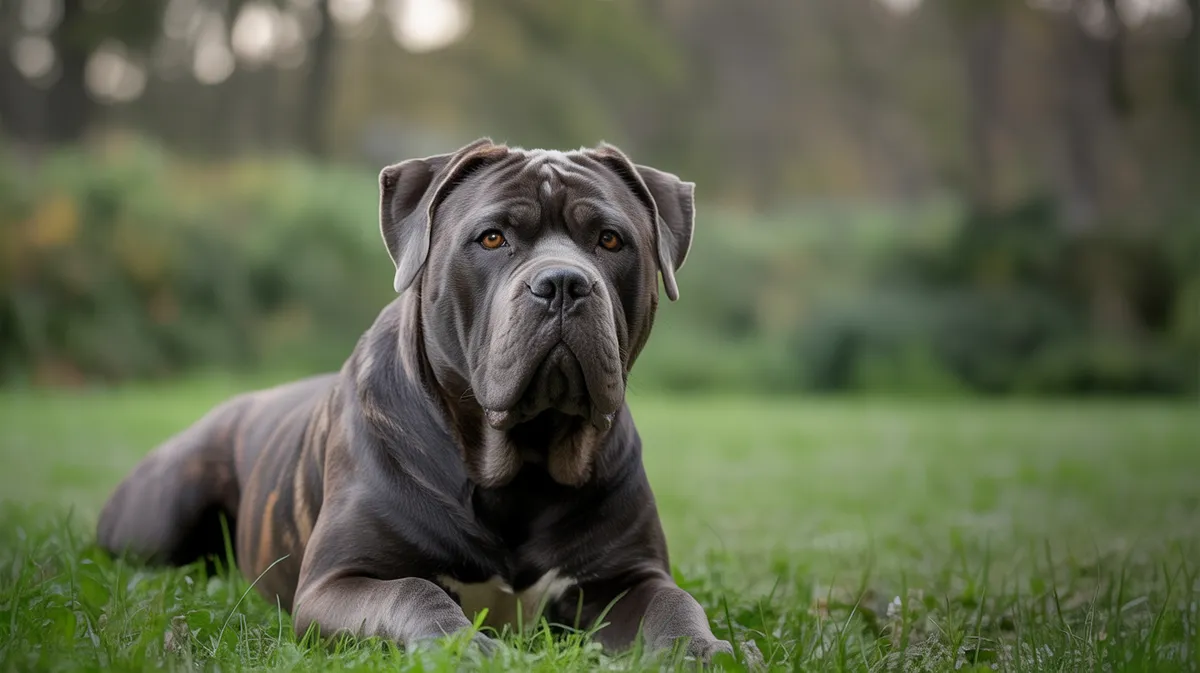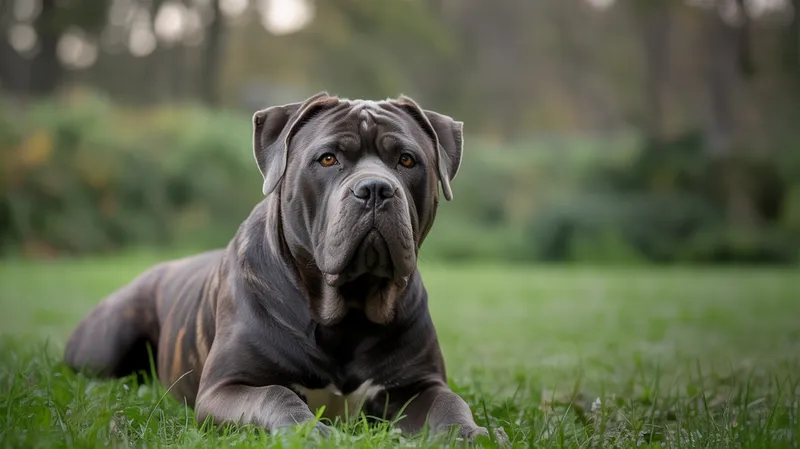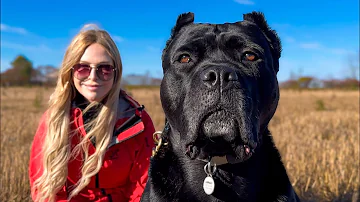
Cane Corso
Canis lupus familiaris

Meet the Cane Corso
The Cane Corso is a large, muscular Italian breed of dog originally developed as a guard dog and hunter of large game. Known for its intelligence, loyalty, and protective instincts, this breed is both an affectionate family companion and an effective working dog. Cane Corsos have a short, dense coat and a commanding presence, with an athletic build and powerful jaw. Their alert nature and strong bonds with their owners make them excellent guardians, but they require consistent training and socialization.
Classification
Mammal
Habitat
Domestic; rural and suburban households
Diet
Omnivore
Lifespan
9-12 years
Conservation
Least Concern
Weight
40-50 kg (88-110 lbs)
📖Fascinating Facts
Ancient Heritage
The Cane Corso is descended from Roman war dogs and has a lineage that traces back over two thousand years.
Protective Nature
This breed is highly territorial and forms strong protective bonds with its family, making it an excellent guard dog.
Athletic Build
Cane Corsos are known for their muscular, athletic bodies and require regular exercise to stay healthy and happy.
📋Detailed Description
The Cane Corso is a large, robust molosser-type dog, typically standing 62–70 cm (24–28 in) at the withers for males and 58–66 cm (23–26 in) for females, with weights ranging from 45–50 kg (100–110 lb) for males and 40–45 kg (90–100 lb) for females. Its physique is characterized by a powerful, athletic build, deep chest, and a broad, square-shaped head with a pronounced stop and strong, muscular neck. The breed’s short, dense coat is coarse and water-resistant, commonly found in black, gray, fawn, or brindle colorations, often with a small white patch on the chest. Cane Corsos have a well-developed jaw and a slightly undershot bite, an adaptation from their historical use in hunting and guarding. Their eyes are medium-sized, oval, and typically dark, conveying an alert and intelligent expression. Behaviorally, they are known for their calm, stable temperament, high intelligence, and strong protective instincts, making them both loyal companions and formidable guardians. Socially, Cane Corsos are highly bonded to their families but may be aloof or reserved with strangers, requiring early and ongoing socialization. Their working heritage is evident in their high energy levels and need for regular mental and physical stimulation. Reproductive maturity is typically reached between 18 and 24 months, with females coming into estrus twice yearly. Unique among mastiffs, the Cane Corso maintains a balance of agility and strength, allowing it to excel in diverse roles from property protection to advanced canine sports.
💡 Did you know?
The Cane Corso nearly went extinct in the mid-20th century but was revived by dedicated enthusiasts in Italy during the 1970s.
🔬Research & Sources
Wikipedia Summary
The Cane Corso is an Italian breed of mastiff. It is usually kept as a companion dog or guard dog; it may also be used to protect livestock. In the past it was used for hunting large game, and also to herd cattle.
Last Modified: 4/29/2025
🎭Behavior & Social Structure
Cane Corsos exhibit a vigilant and territorial disposition, often patrolling their environment and responding quickly to perceived threats. Their behavior is marked by a strong desire to protect their home and family, and they are known to form deep attachments to their primary caregivers. As descendants of working dogs, they retain a high prey drive and may display chasing or herding behaviors, especially when untrained. Feeding behavior is typical of large breeds, with a preference for high-protein diets to support their muscular build. Social interactions within the household are generally affectionate and gentle, especially with children, though their size and exuberance require supervision. Daily routines should include structured exercise, such as long walks, running, or agility training, to prevent boredom-related behaviors like destructiveness or excessive barking. Cane Corsos are intelligent and responsive to positive reinforcement training, but they can be independent and require a confident, consistent handler. They are generally tolerant of other animals if raised with them, but same-sex aggression and dominance behaviors can occur, particularly among unneutered males.
👶Reproduction & Life Cycle
Cane Corsos reach sexual maturity between 12 and 18 months, though breeding is recommended after two years of age to ensure full physical and behavioral maturity. The breed exhibits typical canine mating behavior, with females coming into estrus (heat) approximately every six months. Gestation lasts about 63 days, after which litters of 6–10 puppies are common, though larger litters are not unusual. Parental care is primarily provided by the dam, who nurses and tends to the puppies for the first 3–4 weeks. Breeders often begin early socialization and gentle handling by 2–3 weeks of age to promote stable temperaments. Weaning occurs gradually between 4 and 8 weeks, after which puppies are introduced to solid food and basic training. Responsible breeding practices emphasize health screening for hereditary conditions such as hip dysplasia, entropion, and cardiac issues, which are known to affect the breed.
🛡️Adaptations & Survival
The Cane Corso’s physical adaptations include a dense, short coat that provides protection against the elements while allowing for agility and speed. Its large, muscular frame and powerful jaws are evolutionary traits inherited from ancient Roman war dogs, enabling it to subdue large prey and deter intruders. The breed’s keen senses—particularly hearing and sight—support its role as a guardian, while its high intelligence and trainability reflect selection for versatile working abilities. Behaviorally, the Cane Corso demonstrates situational awareness and an innate ability to assess threats, making it an effective deterrent against predators or human intruders. Its stamina and endurance are well suited for long patrols or active rural lifestyles.
🎨Cultural Significance
The Cane Corso holds a prominent place in Italian cultural heritage, tracing its lineage to the ancient Roman canis pugnax, used in warfare and as a guardian of property and livestock. Historically, it was a symbol of strength and loyalty, often depicted in rural Italian art and folklore as a protector of the homestead. In modern times, the breed has gained international recognition for its working abilities and as a loyal family companion. The Cane Corso is celebrated in Italian proverbs and literature as an emblem of courage and fidelity, and it remains a source of national pride, with dedicated breed clubs and enthusiasts worldwide.
🔬Recent Research & Discoveries
Recent genetic studies have clarified the Cane Corso’s relationship to other molosser breeds, confirming its distinct lineage and highlighting the importance of maintaining genetic diversity. Ongoing research focuses on the prevalence of hereditary diseases, with international breed registries collaborating to develop health screening protocols. Behavioral studies have examined the effects of early socialization and training on aggression and anxiety, emphasizing the breed’s responsiveness to positive reinforcement. There is growing interest in the Cane Corso’s suitability for service and therapy work, with pilot programs exploring its potential in search-and-rescue and emotional support roles. Advances in veterinary medicine have improved the management of breed-specific health conditions, contributing to increased longevity and quality of life.
🎥Wildlife Videos

Cane Corso | Animated | Wildlife Documentary | Informative #biography#wildbirds#seaanimals#nature
Cane Corso | Animated | Wildlife Documentary | Informative #biography#wildbirds#seaanimals#wild ...
Animals World.official

Kangal Dog vs Cane Corso | Animated | Wildlife Documentary | Informative #biography#wildlbirds
Kangal Dog vs Cane Corso | Animated | Wildlife Documentary | Informative ...
Animals World.official

King Cane Corso Dog Breed #animalfacts #animaldocumentary 3.16
Dive into the world of the Cane Corso, a majestic and powerful dog breed that hails from Italy. Known for their large and muscular ...
LearnLand

THE CANE CORSO - POWERFUL ROMAN DOG OF WAR
The Cane Corso is descended from the huge Molossus dogs of war used in ancient Rome and in the Roman Army's world ...
Animal Watch

THE CANE CORSO - THIS GUY HAS THE FITTEST CANE CORSOS IN THE WORLD!
Many modern day Cane Corso dogs are fat, unhealthy & bow backed. Some are mixed with Neapolitan Mastiffs to make them ...
Animal Watch

Cane Corso VS Leopard
Check out more videos: @ViralBe The Cane Corso VS The Leopard. One of the strongest dog breeds, against a Wild Predator.
ViralBe
🌍Habitat Information
The Cane Corso typically inhabits Domestic; rural and suburban households environments. Cane Corsos have adapted to their environments with specialized features and behaviors.
Primary Habitat:
Domestic; rural and suburban households
More detailed habitat information will be available soon.
🛡️Conservation Status
The Cane Corso is currently classified as Least Concern. Conservation efforts are crucial for preserving this species for future generations.
Common Threats:
- 🏠Habitat loss and fragmentation
- 🌡️Climate change impacts
- 🎯Hunting and poaching
- 🏭Human-wildlife conflict
⚠️Threats & Conservation Challenges
While the Cane Corso is not considered at risk globally, the breed faces challenges related to irresponsible breeding, including the propagation of hereditary health issues such as hip and elbow dysplasia, cardiac disease, and certain eye disorders. Overbreeding to meet demand has led to variability in temperament and health, prompting concerns among breed organizations. In some regions, the Cane Corso has been subject to breed-specific legislation due to its size and perceived aggression, which can lead to abandonment or euthanasia. Population trends are stable in most countries, but preservation of breed standards and responsible ownership remain ongoing challenges. Education on proper training, socialization, and health screening is critical to ensuring the breed’s long-term welfare.
🔬Scientific Classification
Scientific Name
Canis lupus familiaris
Classification Hierarchy
🔍 About Taxonomic Classification
Taxonomic classification is a hierarchical system used by scientists to classify and organize living organisms based on shared characteristics and evolutionary relationships.
The system moves from broad categories (Kingdom) to increasingly specific ones, with each animal's scientific name typically consisting of its Genus and species.
📝Community Notes
Share your observations and insights about the Cane Corso with our community of wildlife enthusiasts.
Join Our Community
Sign in to share your observations and connect with fellow wildlife enthusiasts.
Sign In to ContributeNo community notes yet
Be the first to share your observations about the Cane Corso!
Explore Cane Corso
Select a tab above to learn more about this amazing animal.
📸Photo Gallery
No photos available for this animal yet.
🌟Discover More Wildlife
Continue your journey of discovery with more fascinating animals from our database
